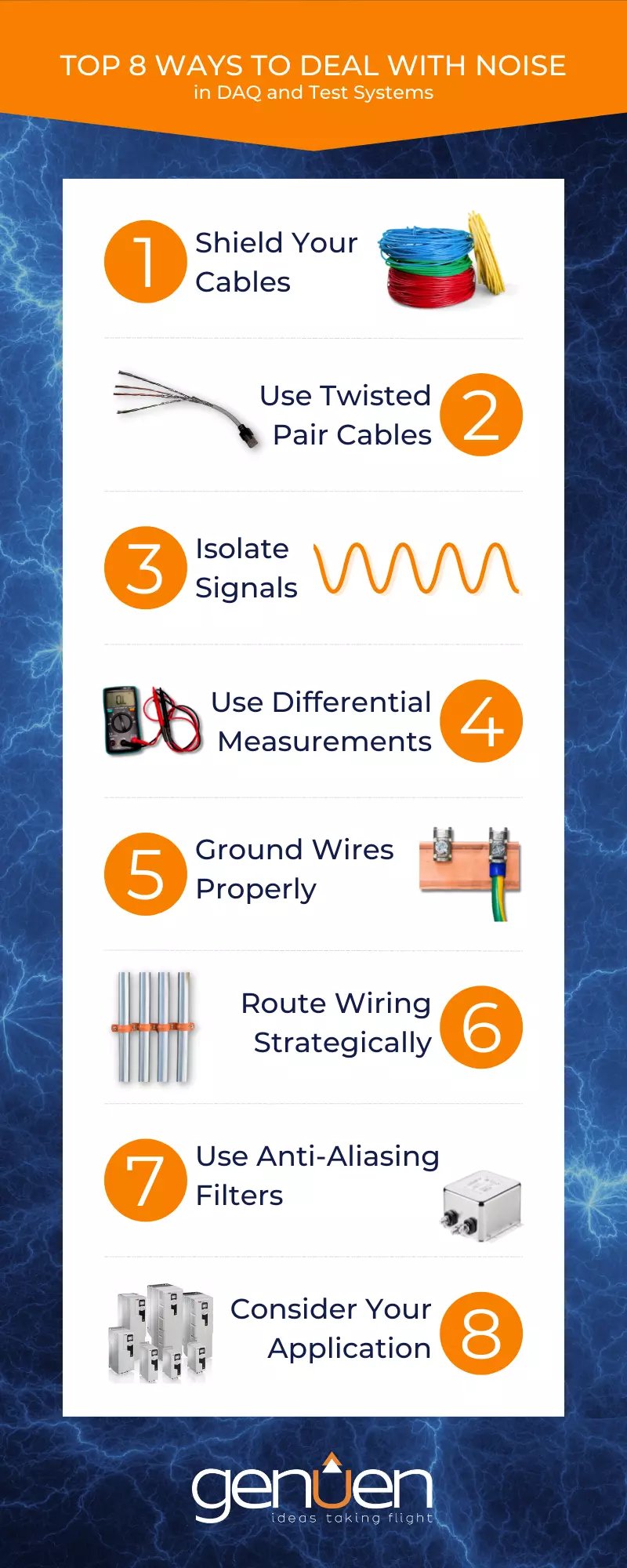Measuring analog signals within a data acquisition (DAQ) system is not always as simple as wiring the signal source leads to the measurement equipment. Data integrity is dependent on clean electrical signals being sent to and received from the electrical devices being controlled and monitored.
Electrical noise can obscure electrical signals and make them unrecognizable, impairing an otherwise capable DAQ system. Noise in a DAQ that is part of a test system for mission-critical applications could be the difference between a plan landing safely and a catastrophic crash.
How do you mitigate the effects of noise to ensure accurate testing? Below, we've gathered the top 8 ways to deal with noise in DAQ and test systems.
Types of Noise Coupling
Before we get into the ways we can mitigate the effects of noise, we must first understand what electrical noise is. For the purposes of this blog post, we are going to focus on coupled noise, which is noise from external sources that can affect the measurement signals in your system. There are two types of noise coupling: common mode and normal mode.
Common Mode Noise is electrical interference on two signal lines that causes both lines to change the voltage of both signals, relative to ground.
Normal Mode Noise is electrical interference on one of two signal lines that causes a change in the voltage referenced between the two signals. This is similar to common mode noise except that only one of the signals is affected.
Coupled Noise Sources
Coupled noise can come from a couple different external sources.
Electrostatic Noise occurs when a conductor is exposed to a time-varying electrical field and voltage is induced. This is also commonly referred to as capacitively coupled noise. The following sources of electrostatic noise are common when dealing with DAQ in test systems:
-
-
-
Variable frequency drive (VFD) motor cables
-
Switch mode power supply conductors
-
Fluorescent lights
-
Squealing bearings
-
-
Electromagnetic Noise occurs when a conductor is exposed to a time-varying magnetic field and current will is induced. This is commonly referred to as inductively coupled noise. The following are common sources of electromagnetic noise:
-
-
-
VFD motor cables
-
AC power cables
-
Switch mode power supply conductors
-
Solenoid power contactors
-
Ground loops
-
-
Top 8 Ways to Deal with Electrical Noise
Many of the sources of electrical noise are essential to effective product testing. So, how do you ensure that electrical noise does not interfere with the accuracy of your tests. Below are 8 of the best ways to deal with electrical noise.

1. Shield Your Cables
Proper use of shielded cables in a data acquisition system will help minimize common mode electrostatic noise. When a shield surrounds a signal wire(s), the signal wire will capacitively couple to the shield but cannot capacitively couple to any conductors outside the shield. This can be used to keep electrostatic noise out of the conductors within a shield cable, but can also be used to keep electrostatic noise contained within the shield.
As a rule of thumb, all measurement signals should be connected to the system using shielded cables. It is also important to use shielded cables on power cables in the system that contain signals with high frequency, time varying signals to minimize their effect on other parts of the system. This typically includes devices that are being driven by pulse width modulated signals, such as the cables that connect variable frequency drives to their respective motors, solenoids that are switched during data acquisition, and solenoids that are driven by PWM signals. When using shielded cables, you must ensure that shield is properly terminated.
Typically, only the zero-signal reference potential (common) end of the shield is terminated for the signals contained within a shield. In special circumstances, shields may be terminated at both ends, but you must ensure that there is no difference in potential between either ends of the shield to prevent a ground loop induction.
2. Use Twisted Pair Cables
The use of twisted pair cables will help to eliminated normal mode noise as each of the conductors in the pair is equally exposed to any sources of electrostatic and/or electromagnetic noise.
Twisted pair cables also help to minimize the magnetic field created by the current in the conductors. Each conductor in a pair carries the same current, except in opposite directions; therefore the magnetic fields for the conductors cancel each other out.
3. Isolate Signals
Some systems require multiple ground planes either due to the physical size of the system or in order to isolate noisy devices from the data acquisition system. It is important to ensure that the signal wiring does not create a return path between two ground planes of different potentials relative to earth ground, creating what is known as a ground loop.
Isolation needs to be provided for any device that has the potential to create a ground loop. Data acquisition modules can be purchased that have on-board isolation or an external device can be used. Care must be taken to ensure that the device can handle the potential difference between the two ground planes, and that the isolator has sufficient bandwidth when isolating analog signals.
4. Use Differential Measurements
It is best to design a data acquisition system using differential measurements wherever possible. Differential measurements help to eliminate any common mode noise and take full advantage of twisted pair cabling.
Theoretically, a differential measurement will eliminate any common mode noise disturbances, however, in real applications, that is not always the case. The common-mode rejection ratio (CMRR) of a differential amplifier can be used to determine how much error is introduced by common-mode voltages and will vary based on the frequency. An ideal amplifier would have an infinite CMRR, but the higher the CMRR the better. Typical instrumentation amplifiers have a CMRR from 70 dB to 120 dB at 60 Hz.
When dealing with high speed differential digital signals (i.e., RS-485, Ethernet, etc.), it is important to select cable with the proper impedance, so that the signal is transmitted with maximum power. Cable with incorrect impedance will cause the square wave shoulders to round off and increase the probability of errors in the transmission.
5. Ground Wires Properly
Proper grounding and ground bonding in the design and installation phases is essential for reducing unwanted noise issues in the DAQ system. Establishing a ground plane can help reduce noise and ensure that all circuits within a system have the same reference potential for comparing different signals and voltages. This ground plane appears to most signals as an infinite ground potential where every point on its surface is at the same potential for all frequencies.
All grounding is designed to establish a low-impedance ground-fault return path to the power source, which is necessary for actuating the overcurrent protection device. To accomplish grounding of all components, the cables and accessories used to acquire data are effectively bonded to the ground plane, which is then bonded to the system earth ground in order to provide a return path for any ground faults. This also provides a zero potential reference to minimize electrical noise from high frequency RF sources.
6. Route Wires Strategically
Wire routing must be considered in order to keep high voltage power and motor wiring noise from affecting low voltage I/O and signal wiring. Segregating signal wires from AC and “dirty” power (such as that from a VFD or servo drive) is essential for good signal integrity. You can accomplish this by separating low voltage from high voltage wires through free air, using separate conduits or tray dividers, steel divider panels and special ducts specifically designed for this purpose. Minimize parallel and overlapping runs of mixed category wiring, and cross cables right angles.
7. Use Anti-Aliasing Filters
While strictly speaking Aliasing isn’t noise, it negatively impacts measurements by distorting waveform data. Aliasing occurs when the sampling frequency isn’t fast enough to account for high frequency content in the signal. When determining the sample rate for a data acquisition system, the sample rate must be at least twice that of the maximum frequency of interest per the Nyquist sampling theorem. In order to prevent aliasing, one must ensure that there the signal does not contain any frequencies above half the sample rate. Anti-aliasing filters can be implemented either in software using oversampling or on the front end of the data acquisition module.
Not only will anti-aliasing filters reduce or eliminate aliasing but as with any high pass filter they will also remove noise at frequencies above the filter cutoff frequency. Additional digital filters could also be added to software to filter out noise at frequencies lower than the Nyquist frequency once aliasing has been addressed. There are many different filter types which must be carefully considered to minimize the effect on measurement data.
8. Consider Your Application
There are many additional considerations that experienced consultants and vendors can help identify. Sensors and other electrical components often have special instructions that must be adhered to. One example we see frequently is that AC drives require special consideration for grounding and shielding of associated cables to effectively reduce noise generated by the drive. The motor cable should be shielded and ground wires grounded at both the drive ground terminals as well as the motor terminal box. Motor cables for motors larger than 30 kW (40 hp) require symmetrically constructed grounding conductors in the cable for optimal electrical performance. Motor cable shielding should also be grounded at both the motor and drive ends using the 360 degree shielding method. A good vendor should be able to help identify these considerations during the purchasing process, but attention should be paid to the documentation that comes with the parts.
Every system is different, so a more in-depth study into each noise problem for your specific application may be required in order to effectively reduce or eliminate a noise issue. Many problems with test equipment can be accounted for up front if your design team has the right experience and understands your end goals. This is far more cost effective and provides better results than fixing them during debug. Speak with a Genuen engineer today to find out how we can help you to design your next system.
FAQs
Next Steps
Real-time test cells encompass a wide array of applications, ranging from simple dynamometers to complex multi-axis servo-hydraulic test cells. The goal of all these test systems is to apply a load or strain on the device under test (DUT) to validate its performance. The results indicate characteristics of the DUT such as efficiency, durability, and operating performance.
Our white paper "Real-Time Control in Test Cell Applications" discusses the basic real-time control requirements necessary for real-time test cell applications.
Contact Us to schedule a free consultation.



